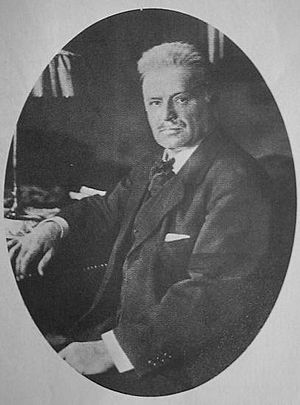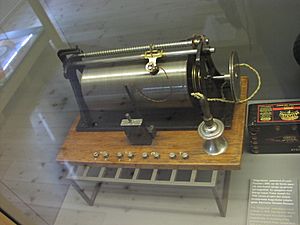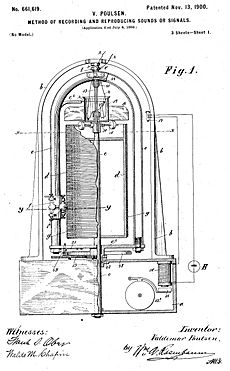Valdemar Poulsen facts for kids
Quick facts for kids
Valdemar Poulsen
|
|
|---|---|

Valdemar Poulsen (around 1898)
|
|
| Born | 23 November 1869 |
| Died | 6 August 1942 (aged 72) Gentofte, Denmark
|
| Nationality | Danish |
| Occupation | Engineer |
| Engineering career | |
| Projects | magnetic wire recorder, arc converter radio transmitter |
Valdemar Poulsen (born November 23, 1869 – died August 6, 1942) was a Danish engineer. He invented a special device called the telegraphone in 1898. This device could record sounds using a magnetic wire.
Poulsen also helped a lot with early radio technology. He created the first continuous wave radio transmitter, known as the Poulsen arc. This invention was very important for sending voice and music over the radio. It was used for many early radio broadcasts. Later, newer transmitters using vacuum tubes replaced it.
Contents
Early life
Valdemar Poulsen was born in Copenhagen, Denmark. His birthday was November 23, 1869. His father, Jonas Nicolai Johannes Poulsen, was a judge. His mother was Rebekka Magdalene Brandt.
Valdemar studied science at the University of Copenhagen. He was there from 1889 to 1893. He left before finishing his degree. After that, he started working as an assistant engineer. This job was at the Copenhagen Telephone Company. Later, he left that job to become an independent inventor.
Recording sounds with magnets
Valdemar Poulsen showed how to record sounds using magnets in 1898. He did this with his invention, the telegraphone. Magnetic wire recording uses a special wire that can be magnetized. This wire moves past a recording head.
An electrical signal, which is like the sound you want to record, goes into the recording head. This creates a magnetic pattern on the wire. This pattern stores the sound. A playback head can then read these magnetic changes. It turns them back into an electrical current. When connected to a phone speaker, this current plays the sound.
Poulsen got a patent for his Telegraphone in 1898. He and his assistant, Peder Oluf Pedersen, made other magnetic recorders. These recorders used steel wire, tape, or disks. These early devices could not make the sound louder electronically. However, the recorded sound was clear enough to hear through headphones. It could also be sent over telephone lines.
At the 1900 World's Fair in Paris, Poulsen showed his invention. He recorded the voice of Emperor Franz Josef of Austria. This recording is thought to be the oldest magnetic audio recording still existing.
People thought the Telegraphone would be very useful. They imagined it would help with dictation and recording phone messages. It could also be used for news services delivered over the phone. One excited reviewer said it would be as important as the telephone itself. But the device was complex. Also, it couldn't make recordings louder. Because of this, it wasn't used very much and didn't make much money.
Developing radio technology
In 1903, Poulsen created a special type of radio transmitter. It was called the "Poulsen Arc Transmitter." This transmitter was very popular for sending voice and music over the radio. It was used before vacuum tube technology became common.
Poulsen improved an older invention called William Duddell's "singing arc." He made it work at much higher frequencies. This allowed it to create continuous radio waves. Unlike older spark-gap transmitters, these steady waves could carry audio. The most important change he made was using hydrogen gas and a strong magnet inside the transmitter.
In 1907, his system could send messages between Lyngby and Newcastle. This was done with a 100-foot (30-meter) tall mast. In 1908, Poulsen made a wireless phone call. He called 145 miles (230 km) from Ejerg to Lyngby in Denmark. He used only 3 kilowatts of power. In 1910, he made another call. This one was 295 miles (475 km) from Los Angeles to San Francisco in the United States. He used 12 kilowatts for that call. Music played in Berlin was heard 215 miles (345 km) away in Copenhagen.
The Federal Telegraph Company used Poulsen's arc transmitters in the United States. They mainly used them for sending messages over long distances by radio.
By the early 1920s, people stopped using arc transmitters. Other technologies like Alexanderson alternators and vacuum-tube transmitters replaced them. Lee de Forest used arc transmitters for some early radio broadcasts starting in 1907. But he later switched to vacuum-tube transmitters. In his 1950 autobiography, de Forest wrote about how much better vacuum-tube transmitters were. He said he didn't realize that his small audion tube could create radio waves. If he had known, he would have thrown away all his arc machines. This is what eventually happened all over the world.
Death and legacy
Valdemar Poulsen died on August 6, 1942. He received many honors for his work. In 1907, he won the Gold Medal from the Royal Danish Society for Science. In 1909, he received an honorary Doctor of Philosophy degree from the University of Leipzig. The Danish government also gave him the Medal of Merit. When he died, he was a member of important science and engineering groups in Denmark and Sweden.
In 1969, Denmark issued a stamp to celebrate 100 years since Poulsen's birth.
The Valdemar Poulsen Gold Medal was an award given each year. It honored great research in radio technology. The Danish Academy of Technical Sciences gave out this award. It was presented on November 23, Poulsen's birthday. Poulsen himself received the first award in 1939. The award was stopped in 1993.
On November 23, 2018, Google honored him with a Google Doodle for his 149th birthday.
See also
 In Spanish: Valdemar Poulsen para niños
In Spanish: Valdemar Poulsen para niños



